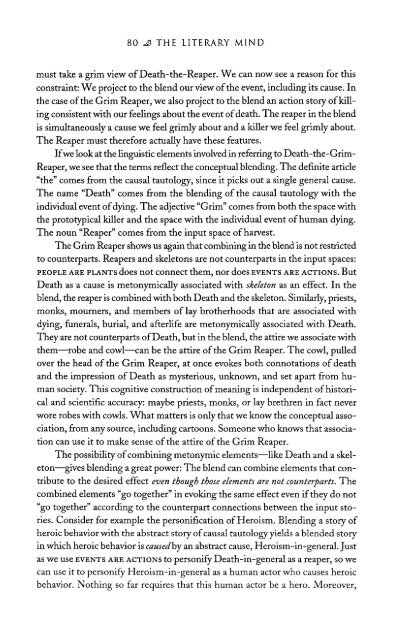The Literary Mind.pdf
The Literary Mind.pdf
The Literary Mind.pdf
Create successful ePaper yourself
Turn your PDF publications into a flip-book with our unique Google optimized e-Paper software.
80 THE LITERARY MIND<br />
must take a grim view of Death-the-Reaper. We can now see a reason for this<br />
constraint: We project to the blend our view of the event, including its cause. In<br />
the case of the Grim Reaper, we also project to the blend an action story of killing<br />
consistent with our feelings about the event of death. <strong>The</strong> reaper in the blend<br />
is simultaneously a cause we feel grimly about and a killer we feel grimly about.<br />
<strong>The</strong> Reaper must therefore actually have these features.<br />
If we look at the linguistic elements involved in referring to Death-the-Grim-<br />
Reaper, we see that the terms reflect the conceptual blending. <strong>The</strong> definite article<br />
"the" comes from the causal tautology, since it picks out a single general cause.<br />
<strong>The</strong> name "Death" comes from the blending of the causal tautology with the<br />
individual event of dying. <strong>The</strong> adjective "Grim" comes from both the space with<br />
the prototypical killer and the space with the individual event of human dying.<br />
<strong>The</strong> noun "Reaper" comes from the input space of harvest.<br />
<strong>The</strong> Grim Reaper shows us again that combining in the blend is not restricted<br />
to counterparts. Reapers and skeletons are not counterparts in the input spaces:<br />
PEOPLE ARE PLANTS does not connect them, nor does EVENTS ARE ACTIONS. But<br />
Death as a cause is metonymically associated with skeleton as an effect. In the<br />
blend, the reaper is combined with both Death and the skeleton. Similarly, priests,<br />
monks, mourners, and members of lay brotherhoods that are associated with<br />
dying, funerals, burial, and afterlife are metonymically associated with Death.<br />
<strong>The</strong>y are not counterparts of Death, but in the blend, the attire we associate with<br />
them—robe and cowl—can be the attire of the Grim Reaper. <strong>The</strong> cowl, pulled<br />
over the head of the Grim Reaper, at once evokes both connotations of death<br />
and the impression of Death as mysterious, unknown, and set apart from human<br />
society. This cognitive construction of meaning is independent of historical<br />
and scientific accuracy: maybe priests, monks, or lay brethren in fact never<br />
wore robes with cowls. What matters is only that we know the conceptual association,<br />
from any source, including cartoons. Someone who knows that association<br />
can use it to make sense of the attire of the Grim Reaper.<br />
<strong>The</strong> possibility of combining metonymic elements—like Death and a skeleton—gives<br />
blending a great power: <strong>The</strong> blend can combine elements that contribute<br />
to the desired effect even though those elements are not counterparts. <strong>The</strong><br />
combined elements "go together" in evoking the same effect even if they do not<br />
"go together" according to the counterpart connections between the input stories.<br />
Consider for example the personification of Heroism. Blending a story of<br />
heroic behavior with the abstract story of causal tautology yields a blended story<br />
in which heroic behavior is caused by an abstract cause, Heroism-in-general. Just<br />
as we use EVENTS ARE ACTIONS to personify Death-in-general as a reaper, so we<br />
can use it to personify Heroism-in-general as a human actor who causes heroic<br />
behavior. Nothing so far requires that this human actor be a hero. Moreover,















